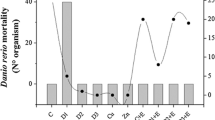Abstract
The BOD inhibition test, the activated sludge respiration inhibition test, and the Microtox® Bioassay procedure were examined for their potential as rapid toxicity screening methods for acid mine drainage (AMD) and for setting toxicity threshold levels in receiving waters. The BOD inhibition test proved to be unsuitable due to the high chemical oxygen demand of the toxicant. The long incubation time (minimum 5 d at 20°C) allowed growth of chemo-autotrophic bacteria and resulted in excessive flocculation and precipitation of metals, making accurate and meaningful measurements of inhibition impossible. The activated sludge respiration inhibition test was successful in measuring AMD toxicity, and for deriving toxicity threshold levels for the basic heterotrophic community in surface waters. However, it is a very time-consuming technique and is not sensitive enough to be used as a routine screening technique. The variability in toxicity was found to be due to the availability of metals as well as the effect of pH on metabolism. Simple linear models were derived to estimate inhibition within surface waters. Prediction of the inhibition caused by AMD can be made as long as the pH of the river water after mixing and the dilution of the AMD are known. Most accurate predictions are made using equations for specific pH ranges, but a useful estimation of inhibition can be obtained using the general equation: inhibition (%) = -2.34 pH + 6.41 AMD (%) + 22.1. The Microtox® Bioassay method, although expensive, was rapid and simple to use. It was the most sensitive test of the three, with the toxic response of marine bacteria increasing notably from 5 to 15 min due to the presence of bivalent metals in the toxicant. The problem of repeatability and reproducibility encountered with the activated sludge inhibition test was overcome with the highly standardised Microtox® method, making it an ideal screening method for AMD. However, the advantage of the activated sludge inhibition test is that the types of heterotrophic micro-organisms found in activated sludge are similar to those found in receiving waters such as the Avoca River and so more meaningful toxicity threshold values can be obtained.
Similar content being viewed by others
References
APHA. 1989. Standard Methods for the Examination of Water and Wastewater, 17th edn. American Public Health Association, Washington DC.
Beckman Instruments. 1982. Microtox ® Systems Operating Manual Analyzer Model 2055. Microbiotic Operation, Carlsbad, CA.
Byrne, C. and Gray, N.F. 1995. Field acute toxicity method for the assessment of acid mine drainage using macro-invertebrates. Fresenius Environmental Bulletin, 4, 583–588.
Department of the Environment. 1982. Methods for assessing the treatability of chemicals and industrial wastewaters and their toxicity to sewage treatment processes. Methods for the Examination of Waters and Associated Materials. HMSO, London.
Department of the Environment. 1988. 5-Day BOD (BOD5) test and dissolved oxygen in water (2nd edn.) Methods for the Examination of Waters and Associated Materials. HMSO, London.
Elnabarawy, M.T., Robideau, R.R. and Beach, S.A. 1988. Comparison of three rapid toxicity test procedures: Microtox®, Polytox and Activated Sludge Respiration Inhibition. Toxicity Assessment, 3, 361–373.
Fitzmaurice, G.D. and Gray, N.F. 1989. Evaluation of manufactured inocula for use in the BOD test. Water Research, 23, 655–657.
Gray, N.F. and O'Neill, C. 1995. Artificial acid mine drainage for use in laboratory simulation studies. Fresenius Environmental Bulletin, 4, 481–484.
Isenberg, D.L. 1993. The Microtox® toxicity test: a developer's commentary. In: M. Richardson (ed.) Ecotoxicology Monitoring. VCM, Berlin.
Kilroy, A. and Gray, N.F. 1994. A Review of Treatability, Toxicity and Biodegradability Test Methods. Technical Report No. 15, Water Technology Research, Trinity College, University of Dublin, Dublin.
King, E.F. and Painter, H.A. 1986. Inhibition of respiration of activated sludges: variability and reproducibility of results. Toxicity Assessment, 1, 27–39.
Klecka, G.M. and Landi, L.P. 1985. Evaluation of the OECD activated sludge respiration inhibition test. Chemosphere, 14, 1239–1251.
Kwan, K.K. 1988. Synthetic Activated Sludge Technique for toxicity assessment of chemicals and environmental samples. Toxicity Assessment, 3, 93–98.
OECD. 1987. Guidelines for the Testing of Chemicals: Activated Sludge Respiration Inhibition Test. Method 209. Organisation for Economic Co-operation and Development, Paris.
Perrin, C.J. 1990. A bioassay for testing the effect of an operational dilution rate of treated AMD on stream function. In: Acid Mine Drainage: Designing for Closure, pp. 451–461. GAC/MAC, British Columbia, Canada.
Sullivan, M. and Gray, N.F. 1996. Toxicity of acid mine drainage (Cu and Zn) and the discharge from a fertiliser factory (NH3-N) on Atlantic salmon Salmo salar L. Water Research, (in press).
Yoshioka, Y., Nagase, H., Ose, Y. and Sato, T. 1986. Evaluation of the test method: activated sludge respiration inhibition test, proposed by the OECD. Ecotoxicology and Environmental Safety, 12, 206–212.
Author information
Authors and Affiliations
Rights and permissions
About this article
Cite this article
Gray, N., O'Neill, C. Acid mine-drainage toxicity testing. Environmental Geochemistry and Health 19, 165–171 (1997). https://doi.org/10.1023/A:1018414908556
Issue Date:
DOI: https://doi.org/10.1023/A:1018414908556




